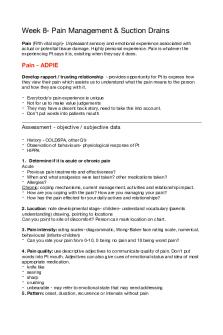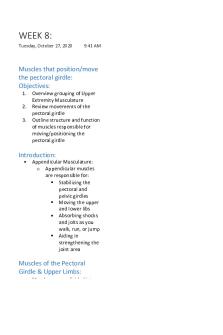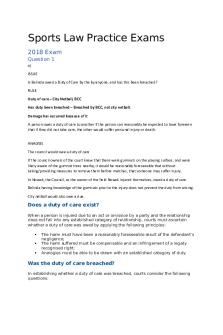Sports law week 8 lecture PDF

| Title | Sports law week 8 lecture |
|---|---|
| Author | Hannah Whitley |
| Course | Sports law |
| Institution | Glasgow Caledonian University |
| Pages | 3 |
| File Size | 70.7 KB |
| File Type | |
| Total Downloads | 75 |
| Total Views | 181 |
Summary
Sports law week 8 lecture notes...
Description
Sports violence and the criminal law
First prosecution for sports and criminal was r v bradshaw o Lots of guidance how criminal law would develop in relation to sport o Foul that resulted in death – was that part of lawfully playing the game? o LJ Bramwell – lawful playing not reason for unlawful act o See his quote from slides o Court required analysis of what players were doing in actual context o Therefore, must look in context and the players conduct – whilst playing a lawful sport! o He gives clear direction how criminal and sports game may be looked at o Must be intent to cause hurt, or there must be recklessness o Foul play in itself not enough to secure convition What must we consider here? o Not just rules of sport, but must also look at rules and practices. Was it in accordance with rules and practices of the game? o Practices not defined by LJ, unhelpfully o Presumably beyond strict interpretation of the rulebook of the game o What would commonly occur within that sport Courts unwilling to impose full force of the law when considering sporting assaults. R v billinghurst 1978 o Case involved off the ball punch at a rugby union game o As a result, victim suffered broken jaw in two places o Defendant argued that the blows of this nature were expected in this game o In other words, fighting a part of the practice? Is this normal practice? Because this is a practice, he argued that victim consented o The victim gave evidence that he had been punched before and he himself had also thrown punches o Former wales international player gave evidence: punching is the exception rather than the rule, he said o Court rejected this argument, people only consent to force that may only be reasonably expected during the game o Not an unlimited licence to go on pitch and do what you like o Punching may well occur, but law says not something you should expect as such o This finding led to defendant being convicted with GBH o S20 Offences against the person Act o 9 Months prison suspended it for two years – meaning that you do not need to serve sentence if you do not get in trouble for two years – again shows that courts don’t want to use full force of law o Judge said that it wasn’t suitable for a custodial sentence as it was during course of sporting game NB that criminal law case more relevant in England
Application of law of consent is at best inconsistent, and at worst misunderstood
Some believe that during sporting event, violence should be treated the same as it was out on a normal road No clear reason as to why it’s not treated the same way? Injury is inherent in many parts of sport – it’s an inherent risk, and player should have a certain degree of tolerance for this, even if deliberately inflicted? Others argue that these issues should be sorted out within the sports itself – retaliation within the game? Some feel that it can be sorted out on the pitch Or indeed that there are governing bodies that they should deal with this ie a disciplinary tribunal Some argue that sport violence is not real violence and should nt get in way of working courts So therefore, conflict here! Internal v external, internal bodies against external ie courts and external legal regulation This is at the heart of sports discussion as regards injuries This is all a participants position, very different if concerning a spectator, abuse of young player, where death occur, or to do with coaches
Role of sports disciplinary tribunals
Quality of procedural justice within sports has improved Many injuries may go through criminal court, but most opting for internal regulation and thus tribunal These tribunals have become more court like in terms of how they are run Because of this victim less likely to complain of unfairness. More stringent penalties imposed also. Less cause for victims complaining Increased robustness is supporting internal regulation Criminal courts no longer considered the only appropriate avenue English perspective here: assault or battery. They have very specific meanings in terms of the criminal law In terms of common assault: the threat that the defendant intentionally or recklessly causes victim injury by unlawful force Battery: intention/reckless application of the force – ie having actually carried out the threat Aim of offence is to protect any unwanted interference. However if victim consents to touching then this is a defence Issue of consent then is issue Mens rea of common assault by battery o Defendant acted intentionally or recklessly when making contact with the victim o Defendant desired to make contact or apply physical force o Alternatively may be subjectively reckless means defendant foresaw a risk but carried on regardless o I.e. in football, footballer may foresee in a tackle that they might come into contact with an opposing player. Therefore acting subjectively recklessly Common assault in England is usually where defendant has caused minor injuries – bruising, grazing etc. this is rarely charged in sporting assaults. Why? Because either
contact with consented, or degree of injury was so minor that it was not sufficient to constitute R v Brownbill o Defendant charged with common assault o Victim repeatedly punched in an ice hockey game, lost two front teeth o Defendant fined £250, and ordered to pay £250 in costs o Case a bit of an anomaly – quite unlikely to happen again
The offences against the person act 1861
S47 S20 S18 All above different degrees of seriousness Ones that go to court
Cases key: billinghurst, r v blissett Sports and consent is a key principle! Homicide Unlawful acts Manslaughter This all falls within remit of criminal courts Corporate homicide also comes in to play o Only applies CMCHA 2007 depending on how death has occurred Not a lot of case law in sctoland, didn’t want to touch on case law for essay Whether or not you consented to contact...
Similar Free PDFs

Sports law week 8 lecture
- 3 Pages

Week 8 - Lecture notes 8
- 6 Pages

Week 8 - Lecture notes 8
- 23 Pages

WEEK 8 - Lecture notes 8
- 10 Pages

Contract Law lecture 8
- 3 Pages

Sports Law Notes
- 28 Pages

Sports Law Practice Exams
- 2 Pages

Week 8 - Lecture notes
- 3 Pages

Week 8 Lecture
- 51 Pages

Tax Law Week 8 - weekly
- 4 Pages

Criminal Law - Week 8 - 8.1 & 8
- 5 Pages

GBCM Week 8 - Lecture notes 8
- 8 Pages
Popular Institutions
- Tinajero National High School - Annex
- Politeknik Caltex Riau
- Yokohama City University
- SGT University
- University of Al-Qadisiyah
- Divine Word College of Vigan
- Techniek College Rotterdam
- Universidade de Santiago
- Universiti Teknologi MARA Cawangan Johor Kampus Pasir Gudang
- Poltekkes Kemenkes Yogyakarta
- Baguio City National High School
- Colegio san marcos
- preparatoria uno
- Centro de Bachillerato Tecnológico Industrial y de Servicios No. 107
- Dalian Maritime University
- Quang Trung Secondary School
- Colegio Tecnológico en Informática
- Corporación Regional de Educación Superior
- Grupo CEDVA
- Dar Al Uloom University
- Centro de Estudios Preuniversitarios de la Universidad Nacional de Ingeniería
- 上智大学
- Aakash International School, Nuna Majara
- San Felipe Neri Catholic School
- Kang Chiao International School - New Taipei City
- Misamis Occidental National High School
- Institución Educativa Escuela Normal Juan Ladrilleros
- Kolehiyo ng Pantukan
- Batanes State College
- Instituto Continental
- Sekolah Menengah Kejuruan Kesehatan Kaltara (Tarakan)
- Colegio de La Inmaculada Concepcion - Cebu



